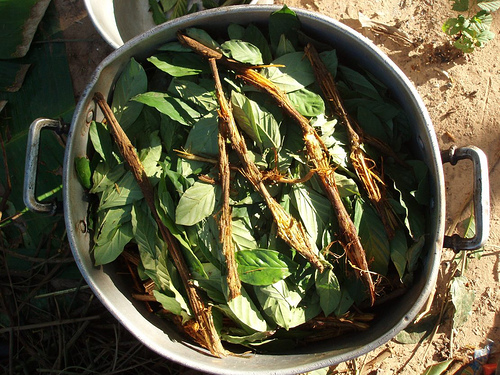Understanding the relationship between sacred plants and Indigenous peoples across the Americas is important to comprehend many of the current Indigenous-driven movements rising in this continent. That is because some of us as outsiders or spectators just know what the media let us see of those movements, but the deepest rationale underlying them are not mainstream and since it challenges topics starting from the colonial ruling status quo to the rational western scientific knowledge. To acknowledge the millenary relationship between Indigenous peoples and sacred plants, its spiritual relations, its role as intermediary in the interaction between humans and the rest of our relatives inhabiting the earth and the spiritual dimensions is more likely a step backwards in the minds of most people unfamiliar—or knowledgeable but in a superficial manner—with the complex interaction they are part of. The aura of mythology surrounding topics about the relations between sacred plants and humans places this interaction in a distant past when science was not as ‘refined’ as now, it is certainly contextualized with the idea of the noble savage who lived in peace with nature long ago. However, these plants are so present now as they were in our past and they have a lot to teach all of us. This paper thus seeks to shed light on the role and the position those plants occupy among Indigenous lives in a contemporary context.

In the background, sage stick smoke during the Stop Kinder Morgan March Sep. 19th 2016. By Victor Sauca
A model of development proposed by some Indigenous nations is the most viable if we take into account all the environmental and social failure that western science has turned to be. The Indigenous model encloses a collective and holistic shift guided by principles of respect for diversity and the singular contributions that each nation can make to heal us and Mother Earth and, to construct a better present and future. This model is called the Fourth Way and is opened to all the useful knowledge that the development of western science can contribute, it is a collective approach in all senses.
Put in a simplistic way for comparison purposes, whereas Indigenous knowledge and wisdom comes from nature and flows in harmony with it, western science comes from objective rationalization, is limited to observable phenomena and void of any spiritual sense. Moreover, since sexist western perception of nature has always put Mother Earth as a source of resources to serve white men—the pinnacle of civilization—and this view has taken over worldwide, there is a need to ‘insufflate life’ to the general population’s understanding of the relations between humans and earth; and Indigenous knowledge has this breath of life. This paper just focuses on Indigenous peoples of the Americas, but the Fourth Way process encompasses Indigenous and non-Indigenous from all over the world.

Ayahuasca y chacruna – cooking I. By Awkipuma. Source: Wikimedia commons, via Creatice commons.
Because of the close relationship between Aboriginals and sacred plants, they know how nature speaks and the ways through which it manifests. However, across history, any use of sacred plants has been discredit by the ruling ideologies of the orthodox scientific community. The reasons might be the superficial or only physical knowledge that those scientists have about these plants or the pressure to conform Western social standards that punish their consumption. In that regard, Kenneth W. Tupper & Beatriz C. Labate (2014) of the University of British Columbia and Center for Research and Post Graduate Studies in Social Anthropology, Guadalajara, respectively, propose a shift in the perception of some psychedelic master plants within the scientific circle. They pose a comparison between the usage of psychedelic plants and scientists’ tools, such as a microscope, as a means to sharpen human limited senses and perceptions. They suggest that empirical Indigenous traditions might “foster new kinds of intellectual and cultural creativity within Western societies” and that the convergence of western technologies and knowledge obtained from sacred plants “may represent the cross-cultural interchange of a powerful kind of cognitive tool” (Tupper & Lavate, 2014, p. 76). Although quite new and perhaps challenging to the modern dominant colonial status quo, that proposition, or at least the idea underlying it, is not new for Indigenous leaders because they are conscious of what it is that Western science lacks.
The commodification of some sacred plants such as tobacco and coca resulted in products destructive for society. Those plants have been desecrated, repudiated and at the same time so appreciated and demanded after they were taken out of their traditional context of use. These plants became sources of addiction and social degradation through western manipulation. However, these plants continue to heal and to be sources of knowledge among Indigenous elders—in the Americas at least—and they play key roles in the gatherings of Indigenous nations because each people brings its knowledge and share ceremonies using these plants. Moreover, a master plant called Ayahuasca has become the target of western scientific studies and pharmaceutical industries because of the boom of its usage in the last decades and its recognized benefits. Although knowledge keepers of Ayahuasca have been cautious and protected it from the hands of capitalism and industrialization, the plant is in danger already due to its increased demand and the industrial sector’s economic interest in that plant.
All the ideas presented above will support my argument on the need to understand the relation between sacred plants and Indigenous peoples in a contemporary context. I hope I will be able to state clearly what these plants have for us and who/what they have to be protected from. I also hope help raise awareness among the readers about the complexity of the Indian movement and not to look only through western lenses, but instead to start thinking in a holistic way when they hear something about Indigenous knowledge.
Bibliography:
Balick, J. & Cox, P. (1997). Plants, people, and culture. New York: Scientific American Library.
Beck, P. V., & Walters, A. L. (1977). The sacred: Ways of knowledge, sources of life. Tsaile, Ariz: Navajo Community College.
Consejo Interamericano Sobre Espiritualidad Indígena. (2016). Declarations. Retrieved from https://ciseiweb.wordpress.com/declarations/
Del Río, A. (2015, October 5). Interview – Alonso Del Rio – Working with Plant Medicines [Video file]. Retrieved from https://www.youtube.com/watch?v=0GxAaR3RN8M
Fourth World International Institute. (2015). The Fourth Way: An Indigenous Contribution to Building Sustainable and Harmonious Prosperity in the Americas and Beyond-2015- 2019. Retrieved from https://es.scribd.com/document/265671129/The-Fourth-Way- 2015-2019
Tupper, K. W., & Labate, B. C. (2014). Ayahuasca, psychedelic studies and health sciences: The politics of knowledge and inquiry into an Amazonian plant brew. Current Drug Abuse Reviews, 7(2), 71-80.
 Follow
Follow